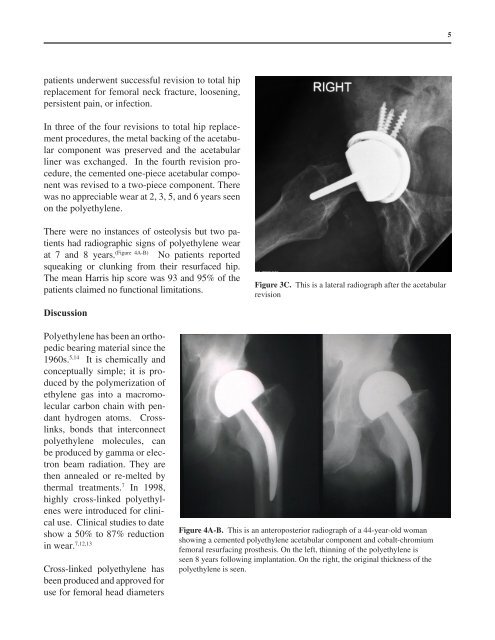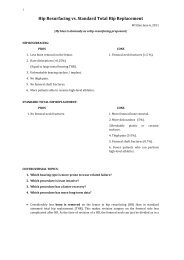Polyethylene Hip Resurfacing for Women by Dr. Pritchett
Polyethylene Hip Resurfacing for Women by Dr. Pritchett
Polyethylene Hip Resurfacing for Women by Dr. Pritchett
- No tags were found...
Create successful ePaper yourself
Turn your PDF publications into a flip-book with our unique Google optimized e-Paper software.
5patients underwent successful revision to total hipreplacement <strong>for</strong> femoral neck fracture, loosening,persistent pain, or infection.In three of the four revisions to total hip replacementprocedures, the metal backing of the acetabularcomponent was preserved and the acetabularliner was exchanged. In the fourth revision procedure,the cemented one-piece acetabular componentwas revised to a two-piece component. Therewas no appreciable wear at 2, 3, 5, and 6 years seenon the polyethylene.There were no instances of osteolysis but two patientshad radiographic signs of polyethylene wearat 7 and 8 years. (Figure 4A-B) No patients reportedsqueaking or clunking from their resurfaced hip.The mean Harris hip score was 93 and 95% of thepatients claimed no functional limitations.Figure 3C. This is a lateral radiograph after the acetabularrevisionDiscussion<strong>Polyethylene</strong> has been an orthopedicbearing material since the1960s. 5,14 It is chemically andconceptually simple; it is produced<strong>by</strong> the polymerization ofethylene gas into a macromolecularcarbon chain with pendanthydrogen atoms. Crosslinks,bonds that interconnectpolyethylene molecules, canbe produced <strong>by</strong> gamma or electronbeam radiation. They arethen annealed or re-melted <strong>by</strong>thermal treatments. 7 In 1998,highly cross-linked polyethyleneswere introduced <strong>for</strong> clinicaluse. Clinical studies to dateshow a 50% to 87% reductionin wear. 7,12,13Cross-linked polyethylene hasbeen produced and approved <strong>for</strong>use <strong>for</strong> femoral head diametersFigure 4A-B. This is an anteroposterior radiograph of a 44-year-old womanshowing a cemented polyethylene acetabular component and cobalt-chromiumfemoral resurfacing prosthesis. On the left, thinning of the polyethylene isseen 8 years following implantation. On the right, the original thickness of thepolyethylene is seen.






